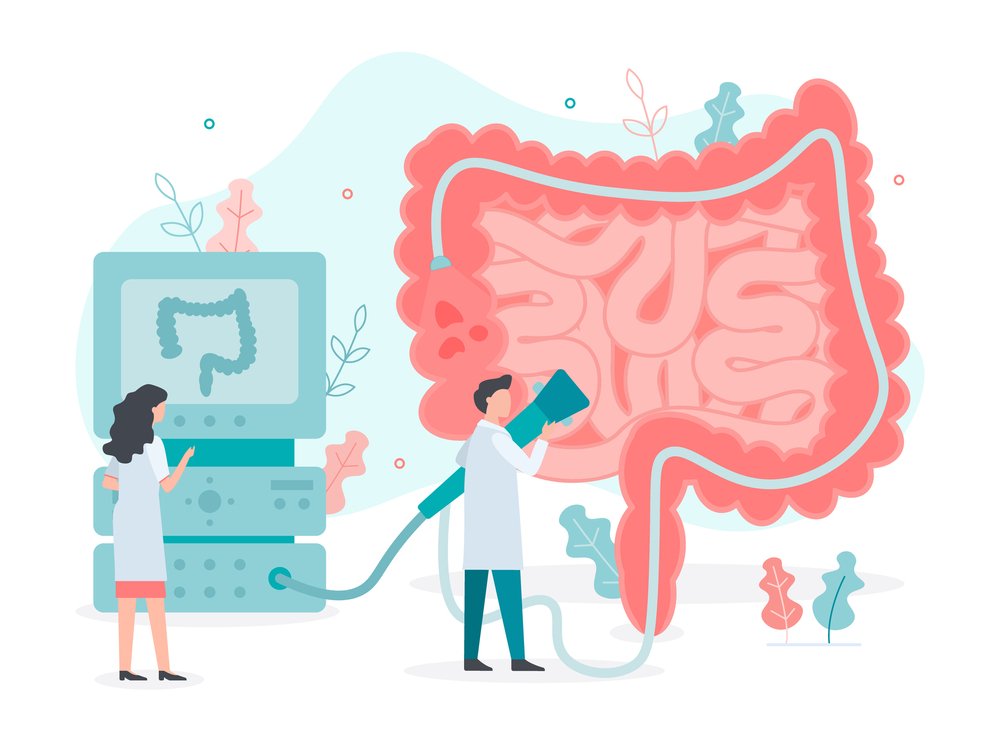Colonoscopy procedure in Türkiye
Colonoscopy is an endoscopic test of the lower digestive system, including the anus, rectum , and colon. It is used to detect changes or abnormalities there by inserting a long, flexible tube into the rectum with a camera on its end, which allows the doctor to view the entire interior of the colon. Polyps can also be removed . Or other types of abnormal tissue during this and taking biopsies for later analysis.

Why is a colonoscopy performed?
Your doctor may recommend a colonoscopy for:
- Check for signs and symptoms of intestinal problems such as abdominal pain, rectal bleeding, chronic constipation, chronic diarrhea and other intestinal problems.
- Colon cancer screening : Colonoscopy is one of the options for colon cancer screening (image 1). Therefore, the doctor recommends a colonoscopy every 10 years after the age of 50. Studies indicate that 90 percent of benign tumors or cancerous tumors can be detected through colonoscopy examinations.
Risks:
Colonoscopy carries few risks and complications are rare, including:
- An adverse reaction to anesthesia during the examination.
- Bleeding at the biopsy site or the area where a tumor or other abnormal tissue was removed.
- A tear in the wall of the colon or rectum.
How to prepare for a colonoscopy in Türkiye:
- Emptying the colon: the colon must be emptied before the endoscopy is not obscured by the remnants of the endoscopy and thus a clear view. A special diet must be followed the day before the test. This may be limited to clear drinks and liquids such as water, tea and coffee without milk, and soft drinks. But red liquids should be avoided to avoid confusion with blood during endoscopy.
- Taking a laxative: The doctor recommends taking a laxative, either in pill or liquid form, the night before and the morning of the procedure
- Using an enema: A series of enemas are used either the night before the test or a few hours before the test to empty the colon.
- Medication control: The doctor must be informed of the medications the patient uses, such as aspirin or blood thinners, such as (warfarin), and medications used to reduce the risk of clots or stroke , or heart medications that affect platelets, such as (clopidogrel), and the doctor may stop them or adjust the doses, including Suits.
During the procedure:
First, the patient wears a special gown for the procedure, then undergoes a kind of anesthesia, which may be a sedative in the form of pills, or a combination of the sedative with an intravenous pain reliever. The procedure begins while the patient lies on his side with his knees pulled towards his chest, then the doctor inserts the colonoscope into the rectum . The endoscope contains a light and a channel that allows the doctor to pump carbon dioxide into the colon, where the co2 inflates the colon, providing a better view of the colonic lining. It also contains a small video camera that transmits images to a screen, enabling the doctor to see what is inside. The doctor can also insert tools through the channel to take biopsies. of tissue or removal of polyps or other areas of abnormal tissue.
Note: The patient feels abdominal cramping or the urge to defecate when moving the scope or when pumping air. Colonoscopy usually takes about 30 to 60 minutes.
After the procedure:
Sedatives and anesthetics need about an hour to wear off, so it is preferable to have someone accompany the patient when he returns home and not drive a car, make important decisions, or return to work for the rest of the day.
The patient may feel bloated or pass gas for a few hours after the test, and walking helps relieve this
It may be noted that a small amount of blood comes out with the first bowel movement after the test, but if the blood continues to come out or what clots from it, or if you suffer from persistent abdominal pain or fever, you should consult a doctor.
Colonoscopy results:
The doctor reviews the results of the colonoscopy and then informs the patient of the results.
negative result:
The result of the endoscopy is considered negative if the doctor does not find any abnormalities in the colon.
The doctor may recommend another endoscopy:
- Within 10 years: In resolving exposure to an average risk of colon cancer.
- Within 5 years: in the event of a history of benign tumors during previous endoscopy procedures.
Positive result:
Colonoscopy is considered a positive result if the doctor finds any polyps (picture 3) or abnormal tissues in the colon, but statistics indicate that most polyps are not cancerous, but some are cancerous, and this is determined during the analysis of samples in the laboratory and depending on the results and in view of their size is taken Several rigorous procedures to search for more benign tumors. If the doctor finds a polyp or any polyp with a diameter of less than 1 centimeter, the doctor may recommend a repeat colonoscopy in five to 10 years, depending on other risk factors for colon cancer.
The doctor recommends another colonoscopy sooner if:
- More than a superfluous diet.
- A fleshy appendage of more than 1 cm.
- Polyps as well as residual stool in the colon that prevents a full colon examination.
- Polyps with certain cellular characteristics indicate an increased risk of developing cancer in the future.
- Carcinoid benign tumors.
treatment in Türkiye

REHABTÜRK relies on the latest technologies in preventive examination, imaging, medical and diagnostic analysis
For reassurance and assessment of the state of health in the treatment of multiple pathological conditions, we also have a special team of medical advisors to provide information to the patient before the operation, follow-up of the patient and provide post-treatment care.
Do you want medical advice about treatment in Türkiye?
Our network consists of dozens of hospitals and hundreds of doctors, and we will be with you from this moment until you fully recover your health. Consult doctors now.

